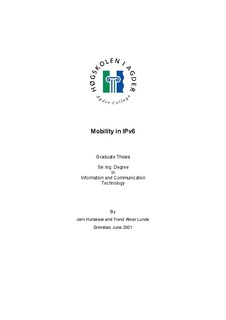| dc.description.abstract | In the future it is expectable that the number of terminals with wireless access to network resources will be more and more widespread, and it is therefore necessary to integrate mobility support into future generation networks so that users can be online, even while in motion. The increasing use of Internet suggests that the Internet technology can be the best candidate for effective realization of future generation mobile systems. Mobile IP can offer the possibility for use of the mobile Internet in other ways than it is used in the standard wired environment, and may be the solution to increasing mobility demands. Due to this, mobility in IPv6 (MIPv6) is designed to be scalable, stable, efficient and secure, which are the factors considered important for this thesis.
Scalable – The number of users are expected to be so many that MIPv6 is, according to its specification, designed to scale almost as well as Internet without mobility support integrated. This implies the elimination of triangle routing, currently a challenge in MIPv4, and also a reasonable amount of data that must be managed by the nodes involved in mobility. MIPv6 is also designed so that future extensions and modifications are possible by allowing further growth.
Stable – For the adoption rate of this technology to high, the users must be able to depend on the services provided. At present the implementations shows that there are still a few more steps to take until necessary stability is offered, but product quality releases of MIPv6 is expected to be released sometime next year. The implementation tested in this thesis reflects transparent mobility as to simple higher-level applications such as telnet and http, but not real-time applications. The implementation described in this thesis had some initial problems with the procedures for Duplicate Address Detection (DAD), which shall guarantee that all addresses on any given IPv6 network is unique. Some improvements for DAD have therefore been proposed in order to get better solutions as to fault-handling procedures when DAD fails.
Efficient – Base MIPv6 as used in our implementation does not provide the handover efficiency needed for all kinds of applications. Seen from a traditional Internet point of view, the services offered are of best effort quality. A future version of the Internet protocol must, however, be designed to support applications with greater demands to handover latencies, than what a best effort service level can provide. Thus, the handover latency must in these cases be so small that it goes within the boundaries for e.g. demanding real-time applications. Several solutions are proposed for this purpose, but the area of research is still very new and no proposal will be defined for still some time. It seems like the initial mobility deployment phase will be without support for these services, but the technology is very promising and will most likely be integrated as the use of MIPv6 advances.
Secure – In a large mobile environment mobile nodes will not only require Internet access within their own domain. They will also probably visit foreign networks, and as known from GSM infrastructure today, this will not be free of charge. Service providers in foreign domains commonly require authorization to ensure a good business relationship with the client. This leads directly to authentication, and of course accounting (AAA). This AAA infrastructure should be in place before mobile Internet can be deployed worldwide. | en |
